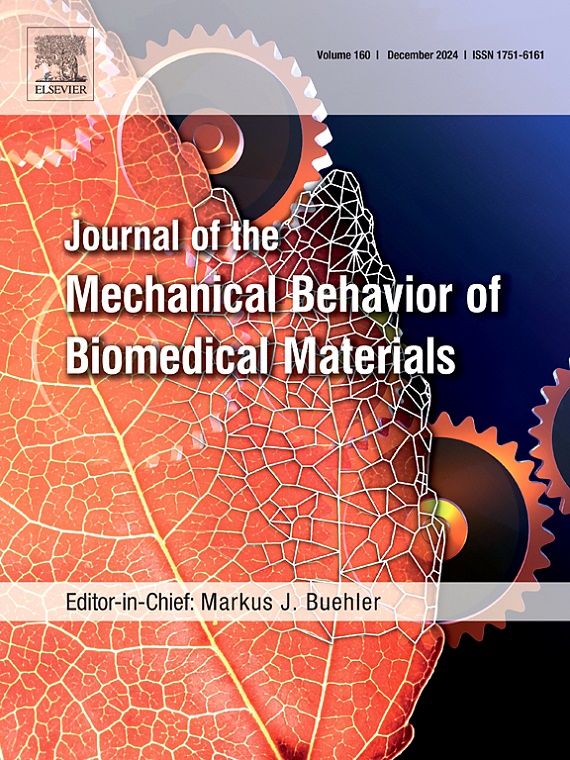Mechanical testing of rubber-like 3D printing materials for cardiovascular modeling applications
IF 3.5
2区 医学
Q2 ENGINEERING, BIOMEDICAL
Journal of the Mechanical Behavior of Biomedical Materials
Pub Date : 2025-06-04
DOI:10.1016/j.jmbbm.2025.107075
引用次数: 0
Abstract
Three-dimensional (3D) printing has attracted considerable attention in cardiovascular applications, offering potential in both clinical practice and in vitro studies. Accurate reproduction of cardiovascular structures depends not only on imaging accuracy but also on the mechanical properties of printed materials. This study focuses on the mechanical characterization of a new series of rubber-like materials, the Vessel Wall () series, designed specifically for cardiovascular applications. Six material blends, with increasing stiffness levels, were evaluated through uniaxial and biaxial tensile tests to assess their mechanical behavior and potential suitability for vascular modeling. Results from uniaxial tests showed that the , and materials present elastic moduli between 0.7 and 0.9 MPa, within the range of compliant vascular tissues, while the stiffer blends (–), with stiffness in the range 1.1–3.2 MPa, may be more suitable for representing pathological or device-interaction scenarios. An overall isotropic behavior was observed, with minimal influence of print orientation on the mechanical response. In biaxial tests, stress correlation between orthogonal directions showed high linearity (R = 0.97 ± 0.02), confirming the isotropic mechanical behavior of all blends. In conclusion, the series offers a tunable and reproducible set of materials, with elastic properties comparable to cardiovascular tissue, although not capturing their complex mechanical behavior. This study provides a practical reference for an informed selection of materials for different cardiovascular modeling scenarios.

用于心血管建模应用的类橡胶3D打印材料的机械测试
三维(3D)打印在心血管应用中引起了相当大的关注,在临床实践和体外研究中都有潜力。心血管结构的精确复制不仅取决于成像精度,还取决于打印材料的机械性能。这项研究的重点是一种新型橡胶状材料的机械特性,即专门为心血管应用而设计的血管壁(VW)系列。通过单轴和双轴拉伸试验,对刚度水平不断提高的六种材料共混物进行了评估,以评估其力学行为和潜在的血管建模适用性。单轴试验结果表明,VW1、VW2和VW3材料的弹性模量在0.7 ~ 0.9 MPa之间,处于柔顺维管组织的范围内,而更硬的共混材料(VW4-VW6)的刚度在1.1 ~ 3.2 MPa之间,可能更适合于表现病理或设备相互作用的场景。观察到整体各向同性行为,印刷方向对机械响应的影响最小。在双轴试验中,正交方向的应力相关性呈高度线性(R2 = 0.97±0.02),证实了所有共混物的各向同性力学行为。总之,VW系列提供了一套可调和可重复的材料,具有与心血管组织相当的弹性特性,尽管不能捕获其复杂的机械行为。本研究为不同心血管建模场景的材料选择提供了实用参考。
本文章由计算机程序翻译,如有差异,请以英文原文为准。
求助全文
约1分钟内获得全文
求助全文
来源期刊

Journal of the Mechanical Behavior of Biomedical Materials
工程技术-材料科学:生物材料
CiteScore
7.20
自引率
7.70%
发文量
505
审稿时长
46 days
期刊介绍:
The Journal of the Mechanical Behavior of Biomedical Materials is concerned with the mechanical deformation, damage and failure under applied forces, of biological material (at the tissue, cellular and molecular levels) and of biomaterials, i.e. those materials which are designed to mimic or replace biological materials.
The primary focus of the journal is the synthesis of materials science, biology, and medical and dental science. Reports of fundamental scientific investigations are welcome, as are articles concerned with the practical application of materials in medical devices. Both experimental and theoretical work is of interest; theoretical papers will normally include comparison of predictions with experimental data, though we recognize that this may not always be appropriate. The journal also publishes technical notes concerned with emerging experimental or theoretical techniques, letters to the editor and, by invitation, review articles and papers describing existing techniques for the benefit of an interdisciplinary readership.
 求助内容:
求助内容: 应助结果提醒方式:
应助结果提醒方式:


